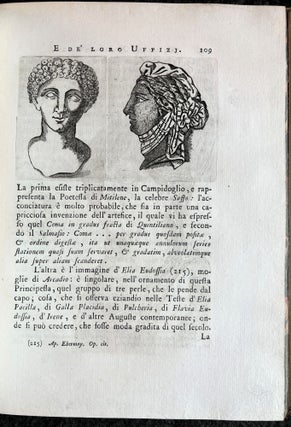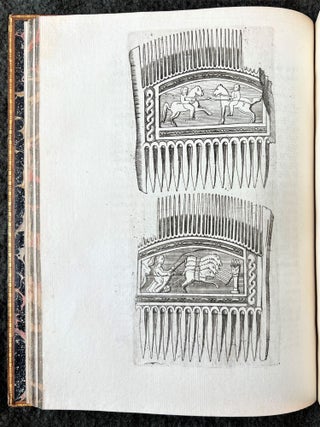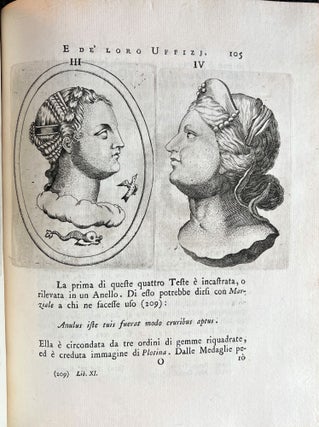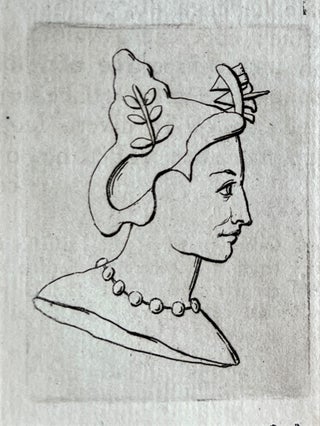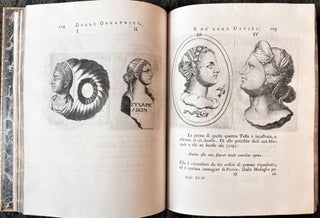Delle Ornatrici, e de' loro uffizj, Ed insieme della superstizione de' Gentili nella Chioma; e della cultura della medesima presso le antiche Donne Romane. Naples: Giovanni Gravier, 1775.
4to (269 x 205 mm). [1] leaf, 10, 179, [1] pages. Eighty-two etched and engraved illustrations, in various sizes including five nearly full-page, type-ornament headpiece & initial, one woodcut initial. Occasional faint offsetting of the engravings, else fine. Nineteenth-century calf, sides with outer triple gilt rule and narrow blind acanthus roll border, marbled edges, marbled endpapers (upper joint cracked, extremities rubbed, scratches). ***
Only edition of an endearingly illustrated study of ancient hair stylists and of feminine hairstyles and hair-related objects and beliefs in ancient Rome. This early work of historical anthropology is unusual for its concentration on the domestic sphere and the world of women in antiquity.
Guasco, poet and antiquarian, was Custode (curator) and President of the Capitoline Museums from 1772 to 1778. For the present work he used literary as well as iconographic sources, many of the latter reproduced in the anonymous engraved illustrations. In his dedication to the Marchesa Anna Anguissola of Piacenza, a patroness and friend, to whom he had already dedicated the related Dissertazione tusculana sopra un'antica iscrizione sepolcrale appartenente ad una ornatrice (1771), which he calls a “sketch” of this longer treatise, Guasco defends himself against potential critics who might accuse him of wasting his time on frivolous subjects, arguing that a study of the customs surrounding hair in Antiquity can contribute to one’s understanding of classical poetry, especially satire and comedy, ancient rites, both sacred and profane, and ancient art. Defending the dedicatee against those who might doubt her interest in antiquarian subjects, he cites other prominent erudite women, including Catherine the Great, Queen Cristina of Sweden, the Marchesa and antiquities collector Anna Grimaldi, and Anna Maria van Schurman, the learned Dutch painter, poet and scholar. Finally, he cites other well known works on supposedly “frivolous” aspects of antiquity, such as Ferrari on clothing, Ficoroni on masks, Pignoria on slaves, Bartholin on childbirth, and one earlier essay on hair, Claude Saumaise, Epistola ... de caesarie virorum et mulierum coma (Leiden 1644).
Citing Plautus’s litany of the many professions required to enhance women’s appearance (Aurularia 3.5), Guasco opens the work with the bold declaration that of all the many body parts requiring cosmetic cultivation, the head of hair, la chioma, is the most essential to “feminine vanity.” He notes the exclusive use of female servants of the toilet by wealthy women, cites epigraphic and literary appearances of the word “ornatrix,” or “what the French call a coiffeuse,” and reproduces a wall painting from Herculaneum of one such stylist in action. Delving into the subject, Guasco examines the evidence not only of classical texts but also of gems, medallions, frescos, surviving domestic objects, busts, statues and funerary inscriptions. He discusses the nature of the work of the ornatrici, the uses, varieties, and materials of hairpins, combs (whose supposedly Etruscan origins he disputes), and other accessories, styles of hair and of hair adornment, hair ointments, and religious rites involving hair. Many epigraphic inscriptions are reproduced in the letterpress text. Two subject indices, one of proper names, and an index of authors cited conclude the work. Guasco’s erudition and precise attention to the details of so many classical artifacts gave this treatise enduring value, comparable to that of his 3-volume work on the epigraphy of the Capitoline collections (Musaei Capitolini antiquae inscriptiones).
Although the edition is well printed, the register of the engravings and the letterpress text is occasionally imperfect, with some overlap. A few pages have blank spaces, due to a miscalculation of the layout required to keep the relevant text with the engravings. This is an attractive, wide-margined copy. OCLC gives 6 US locations. Lipperheide 231 (”wichtig”); Colas 1346. Item #4174
No longer available
Status: On Hold


